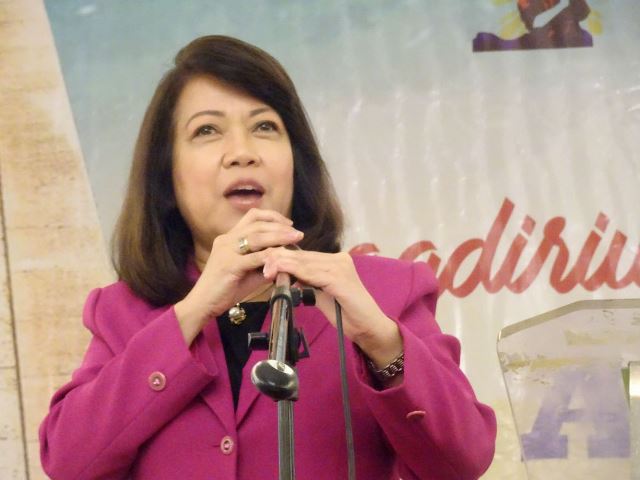Kangaroo Court? Media Supports Attacks on Chief Justice on leave

Chief Justice on leave Maria Lourdes Sereno during the Day of Valor event organized by the Movement Against Tyranny | Photo by Lito Ocampo
NEVER MIND the exalted venue, nor the high status of the persons involved. Bickering is always interesting. Consider then how public attention was transfixed by the bickering among justices in the Supreme Court.
Jeers for media coverage that went after the appeal of the lowest common denominator in reporting the making of judicial history in the High Court. In the presentation of oral arguments on the unprecedented petition for quo warranto filed against the chief justice on leave, Maria Lourdes Sereno, the media reduced the legal exchange to no more than a shouting match among the learned justices.
Media had full access to the proceedings which was streamed live and should have taken time to cull the essential points of the arguments presented by either side.
This is the first time in Philippine history that the chief magistrate has been officially examined and questioned by her colleagues. The heated exchange between Sereno and some of the justices present, particularly Associate Justice Teresita de Castro, let flow a surfeit of soundbytes and quotes. But the media, in highlighting and focusing on these aspects joined the lowering of standards of political discourse.
Filed by Solicitor General Jose Calida, the quo warranto petition questions the validity of Sereno’s appointment as Chief Justice over her alleged incomplete submission of Statement of Assets, Liabilities and Net Worth (SALNs). Sereno’s legal team and other legal experts, including the Integrated Bar of the Philippines, said that the only way a justice of the Supreme Court can be removed from office is by impeachment. Other political commentary had said the quo warranto petition was an alternative explored to oust Sereno more quickly.
And yet the media followed the dominant sentiment ruling the Court, some members of which seemed eager to follow Calida’s lead, using the same SALN issue pursued in the impeachment case in Congress.
Prior to the oral arguments, five justices—De Castro, Francis Jardeleza, Lucas Bersamin, Diosdado Peralta and Noel Tijam—had already testified against Sereno in the House hearings on the impeachment complaint against her. They had their air time and more. Sereno asked that they recuse themselves as they had already pre-judged her.
Acting Chief Justice Antonio Carpio announced before the arguments that these five justices denied Sereno’s motion. While only Manila Bulletin and CNN Philippines reported that the five justices denied Sereno’s motion to inhibit themselves from the proceedings, the bulk of news accounts was given to the grilling of Sereno by the five justices (“SC orals sa quo warranto vs Sereno, nauwi sa maaanghang na sagutan”; “CJ Sereno, nanindigang nagsumite siya ng mga SALN alinsunod sa batas”; “CJ Sereno, nagisa sa pagdinig sa quo warranto petition laban sa kanya”; “Sereno locks horns with De Castro at SC hearing”; “Sereno, De Castro clash at ouster hearing”).
Media reports in the main print and primetime newscasts blatantly ignored the defense made by Sereno’s legal counsel, Alex Poblador, which effectively addressed the points Calida made in his opening statement. These were simply ignored in print and broadcast, an omission which reflects sadly on the influence of politics on the press. Sereno’s side, outside of the catfight, was significantly downplayed.
Philstar.com alone reported Poblador’s defense: “If allowed to do so, what will stop the solicitor general from filing similar petitions against any sitting justice, based on any offense whether impeachable or not, on the theory that such offense can somehow reflect on his integrity and probity?” (“Calida petition endangers separation of powers, Sereno camp says“)
Usually, the media resorts to simply quoting statements from both side to signal their neutrality. What should the public make of this pointed lack of balance in media coverage?
If this is a kangaroo court, then the media seems quite comfortable in the kangaroo’s pouch.
Leave a Reply